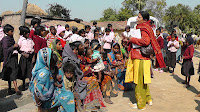
Family Planning in Rural Bihar
Today was the family
planning expedition into rural Bihar, four of us in an old jeep boldly going
where the electric pylons and wires have not gone. I have seen poverty, but
this was literally dirt poor. All mud roads impassable during monsoon, mud and
thatch huts with the animals and people living side by side. No running water
or sewage system, just a shared village pump and open air bathroom in which
ever field took your fancy. The narrow main streets had just enough room for the
jeep and were lined with buffalo or cows grazing just outside the house door or
roaming around amount the goats, chickens and half naked, matted haired
children. Due to living in such un sanitary conditions in close proximity to
animals Dr Sunil told me that villagers suffer from all kind of skin diseases
and worm infestations, along with TB, childhood diseases and malnutrition.
Dr Sunil was also
helpful in translating the conversations between the health worker Sunita and
the village women; being a man it was not culturally acceptable for him to talk
about family planning with women directly. In one village we had to meet with
the men first before we were allowed to talk with the women and the men also
listened it and gave their opinions. This was a new area for EDLT to work in and
we were doing the first on many information sessions to introduce ideas on
family planning and EDLT’s work to the villagers.
The Indian government has a program set up
where they pay for women or men to be sterilized; of course the men will not
even think of having it done so it is up to the women. However the government
relies on local NGO’s to do the leg work of informing the people of this
service, bringing the people to hospital and assisting patients with after
surgery care. The very thought of recovering from a big surgery like that in
the comfort of your own home in the village is just asking for major infection
and come to think of it I am not so sure I would trust a Bihari hospital
either. Anyway EDLT’s family planning program uses the government funded surgery
as a platform to talk about all kinds of contraceptives and offers ideas on how
to plan the gap between children. EDLT tries to encourage parents to have fewer
children and emphasis a better quality of life for the family; such as less
worry, work and money providing for fewer children, getting the children and
education and having time to spend enjoying children. I met women who have 6 or
5 children, they were thin and looked exhausted and were hardly 26. The danger
with big families is that not only may there be not enough food but there is a
high risk that parents will send their children off to work in the city or
worse still sell girls unknowingly into the sex trade. So good family planning,
stops over population and abuse of children.
Sunita and Dr Sunil
were so kind in answering my question about women’s health and told me about
the variety of problem’s women face. Girls getting married in their teens is a
huge problem, because the mother and baby do not get enough nutrition during
those years of maternity and breast feeding. There is a high infant and mother
mortality rate at birth, the villages closes to towns have a higher rate of
AIDs and STD’s and I learned about an infection called Leucorrhoea, brought
about due to bad sanitation which can render a woman infertile; and an
infertile wife in rural India can become a social outcast, since motherhood
brings status. Dr Sunil helped me talk with some of the women and I backed up
what Sunita was saying that having fewer children equals a better quality of
life for everyone; what else could I say. After a day of talking and driving
around to different villages I think Sunita and Dr Sunil had spread the gospel
of fewer children pretty well and I am sure gossip travels fast in the area.
Next week they will go back and talk some more, answer questions and maybe take
along some women from Bodhgaya are who have already gone through the surgery,
and who have used other contraceptive methods. In the village I also noticed
that Suntia would pull in the older women into the conversation to get their
approval and for them to give their opinion. It is essential to get the
approval from the older women and men as they will have a lot of say in how the
program proceeds or does not proceed. I have learned so much today and in many
ways it is hard to describe and truly relay the range of emotions I secretly
went through while seeing such abject poverty. It is also so evident in the village
that education is the key to end poverty. Not necessary a formal university
education, just basic knowledge of health, the human body and nutrition in
relation to the environment, the three R’s and some street smarts about the
world outside the village.


No comments:
Post a Comment